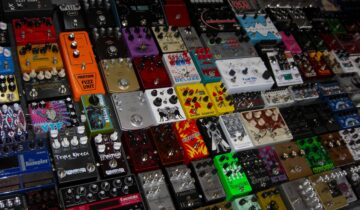 For the ECONOMIST: VINYL evokes another time. In “Call the Midwife”, a drama set in the late 1950s, the young women return from a day of delivering infants to enjoy a Horlicks and a Chordettes record. In “Mad Men”, Don Draper can often be seen nursing an Old Fashioned with some Big John Hamilton or Peggy Lee whirring on the turntable. But LPs remain a potent force in our current musical climate of streaming and digital downloads; 2015 marked the tenth straight year of growth in the American market. According to the most recent Nielsen music report, last year’s performance—12m units sold, grossing a total of $416m—is the best since 1988. Even more surprisingly, the biggest-selling audio device (aside from the iPhone) of that year was not hands-free headphones or Bluetooth speakers but the humble turntable.
For the ECONOMIST: VINYL evokes another time. In “Call the Midwife”, a drama set in the late 1950s, the young women return from a day of delivering infants to enjoy a Horlicks and a Chordettes record. In “Mad Men”, Don Draper can often be seen nursing an Old Fashioned with some Big John Hamilton or Peggy Lee whirring on the turntable. But LPs remain a potent force in our current musical climate of streaming and digital downloads; 2015 marked the tenth straight year of growth in the American market. According to the most recent Nielsen music report, last year’s performance—12m units sold, grossing a total of $416m—is the best since 1988. Even more surprisingly, the biggest-selling audio device (aside from the iPhone) of that year was not hands-free headphones or Bluetooth speakers but the humble turntable.
Many consider nostalgia the driving force behind this uptick. Turntables are cheap and easy to get hold of (a Crosley costs less than $100 on Amazon) and so furnish baby boomers with a good excuse to dust off what remains of their collection, and expand it further. But data show that this isn’t a sufficient explanation: nearly 50% of vinyl customers are 35 or younger, according to ICM. Indeed, it is 25-35 year-olds who are the most voracious demographic, taking home 33% (by comparison, 45-54 year-olds are responsible for only 18% of sales). Millennials might like to carry their favourite songs around with them and discover new artists via streaming apps, but they also want to collect that music in album form.
As such, stores popular with millennials are increasingly stocking vinyl. In 2014, Urban Outfitters, a clothing retailer aimed at 18-28 year-olds, claimed to be the world’s number one vinyl seller (Billboard noted that they can claim an 8.1% share of the American market to Amazon’s 12.3%). They sell the sleek, vintage-inspired Crosley turntables in their stores; the partnership helped to shift more than 1m units in 2015. Calvin Hollinger, the chain’s chief administrative officer, explained this move by stating that “music is very, very important to the Urban customer” and feeds in to the store’s status as a purveyor of a forward-thinking, trendy lifestyle. Hot Topic, a retailer of “alternative culture-related clothing and accessories”, offers vinyl in stores and online. Target and Whole Foods are rolling out vinyl at locations across the country.
Independent record store owners are marketing to millennials, too. Steve Stevenson, owner of 1-2-3-4 Go!, a shop in San Francisco’s Mission District, states that Instagram plays a huge role in his business strategy. The photo and video-sharing social network is overwhelmingly populated by this demographic; over 90% of the app’s 150m users are under the age of 35. Mr Stevenson posts photos of new arrivals, new releases, staff picks and dealer choices. The strategy has resulted in an increase of followers, but also a marked increase—20-30% year on year—in sales. “There’s no line out the door,” Mr Stevenson says. “But there is a strong general interest.”
To truly tap in to the millennial market, however, companies must make vinyl as convenient and on-demand as possible. Partnerships with other ecosystems are key—Instacart provides Whole Foods deliveries, UberEATS offers takeaway delivery “at the tap of a button”—and the music industry should move in the same direction. Some digital-savvy companies have already realised this. Vinylize.it allows fans to crowdfund a vinyl of tracks they have heard online; they simply press a button on SoundCloud and the artist is notified. Qrates, a similar venture, allows artists to press a small number of vinyl records—less than 100, when a typical minimum order is 500—and design the art work themselves. In a couple of months, fans receive the rare printing of their choice. The on-demand vinyl economy is booming so much, in fact, that pressing plants are struggling to keep up.
Taishi Fukuyama, the chief marketing officer for Qrates and Vinylize.it, says that orders are healthy despite many customers admitting to not owning a turntable. Since launching last year, they’ve hosted roughly 2000 vinyl projects on their platforms, primarily in America, Britain and Japan. Mr Fukuyama’s companies were selected this week to participate in a six-month mentorship program with Abbey Road Studios and Universal Music Group.
Some may never play the records they buy, he says, but own them as showpieces and statements of their musical taste. Many see this as a shallow way of accessing music, making vinyl little more than a passing phase, a personal statement more than an appreciated musical artefact (the Telegraph decried that “Half the people buying vinyl don’t actually bother listening to it”). But Mr Fukuyama is more optimistic: “The act of collecting physical objects appeals to enthusiasts in any era. As new vinyl users enter the market in these new ways, a group of these users will eventually convert to loyal customers of the format and will listen to the vinyl,” he said.
In many ways, millennials’ interest in vinyl is not surprising. The item is a mark of individuality and a willingness to go the extra mile to support an artist. “Streaming and downloads are almost like a commodity to a degree, where everything is the same,” says Gary Kelly of Interscope Records. Young supporters “are searching for that premium experience where they can show they are a super fan, and they can have that artwork sitting in their record collection or dorm room.” Whether the uptick will last is yet to be determined: 1-2-3-4 Go! has already noticed a plateau in sales this year. In the meantime, catering to demand is simply good business sense.
Image by gary moskowitz



